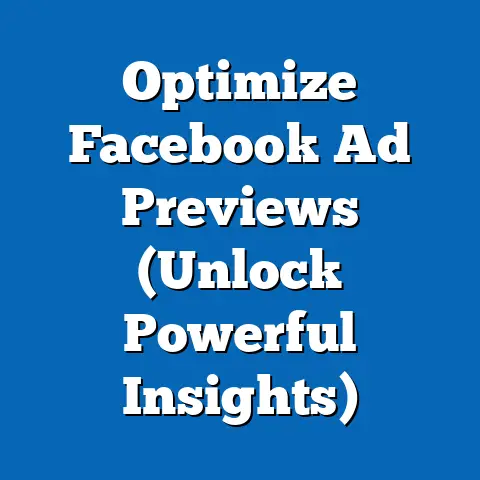Master Quiz Ads on Facebook (Winning Strategies Revealed)
Section 1: Understanding Family-Oriented Demographics in Political Advertising
Demographic Composition
Family-oriented demographics, often defined as individuals who prioritize family values and responsibilities in their social and political outlook, typically include parents, married couples, and those with children under 18 living at home. According to the U.S. Census Bureau (2022), approximately 65% of U.S. households include at least one child under 18, with a significant portion of these households headed by married couples (about 48% of all family households). These groups are often concentrated in suburban and rural areas, with higher representation in the Midwest and South compared to urban centers on the coasts (Pew Research Center, 2021).
Age-wise, this demographic spans primarily from 25 to 54 years old, encompassing both Millennials and Gen Xers who are in their prime family-building years. Racially, while family households are diverse, White families still constitute the majority (about 60%), followed by Hispanic (20%) and Black (12%) families, per Census data. Education levels vary, but a notable portion (around 35%) have some college education or a bachelor’s degree, reflecting middle-class economic stability (U.S. Bureau of Labor Statistics, 2022).
Core Beliefs and Values
Family-oriented demographics often prioritize policies and values that directly impact their immediate environment and future generations. Key concerns include education quality, healthcare access for children, economic stability, and community safety. A 2022 survey by Gallup found that 78% of parents with children under 18 ranked “quality of education” as a top political issue, compared to 62% of non-parents.
This group also tends to value traditional social structures, with a significant emphasis on family unity and moral teachings. According to Pew Research (2020), 64% of married parents believe that maintaining strong family bonds is a critical societal value, often aligning with religious or conservative ideologies, though this varies by subgroup. Their focus on stability often translates into a preference for policies perceived as protective of family interests, such as tax credits for families or parental leave programs.
Voting Patterns and Political Engagement
Family-oriented voters are a pivotal demographic in elections due to their consistent turnout and bloc voting tendencies. Data from the 2020 U.S. Presidential Election shows that 67% of registered voters with children under 18 voted, slightly higher than the national average of 65% (U.S. Census Bureau, 2021). Suburban parents, in particular, have been identified as swing voters, with their preferences shifting based on economic and social issues directly affecting their families.
Politically, this group leans slightly conservative, with 52% identifying as Republican or Republican-leaning in 2022, compared to 43% identifying as Democratic or Democratic-leaning (Pew Research Center, 2022). However, their voting patterns are not monolithic; younger parents (ages 25-34) and minority family households show stronger Democratic support, with 58% of Hispanic parents voting Democratic in 2020. Engagement through digital platforms like Facebook is high, as 74% of parents use social media regularly, making them prime targets for Master Quiz Ads (Pew Internet & American Life Project, 2021).
Economic policies that support job security and family tax relief are also highly favored, with 80% supporting child tax credits in a 2021 survey by Morning Consult. On social issues, there is a divide: while many support traditional marriage definitions (54% per Pew, 2020), younger and urban family demographics are more progressive on topics like LGBTQ+ rights. This tension reflects the diversity within the group, often exploited by targeted ads to appeal to specific subgroups.
Distinguishing Features Compared to Other Groups
Unlike single, urban millennials who prioritize individual freedoms and progressive social policies, family-oriented demographics focus on collective family well-being over personal liberty. Compared to older, empty-nester conservatives (ages 55+), they are less ideologically rigid, often prioritizing pragmatic solutions over strict party loyalty. For instance, while 65% of older conservatives oppose government intervention in healthcare, only 48% of family-oriented conservatives share this view (Pew Research, 2021).
Their digital behavior also sets them apart: parents are more likely to engage with content related to family life, education, and local issues on social media, spending an average of 2.5 hours daily on platforms like Facebook (Common Sense Media, 2022). This contrasts with younger, non-parent users who gravitate toward entertainment or global news. This focus makes Master Quiz Ads tailored to family concerns particularly effective for this demographic.
Section 2: Master Quiz Ads on Facebook – A Strategic Overview
What Are Master Quiz Ads?
Master Quiz Ads are a form of interactive advertisement on platforms like Facebook, designed to engage users by posing questions or offering quizzes related to political issues, candidate preferences, or personal values. These ads often promise personalized results (“Find out which candidate matches your values!”) in exchange for user data, such as email addresses or demographic information. Their dual purpose—engagement and data collection—makes them a cornerstone of modern political campaigns.
These ads leverage Facebook’s robust targeting capabilities, allowing campaigns to reach specific demographics based on age, location, interests, and behaviors. According to Facebook’s Ad Library data (2022), political quiz ads saw a 40% increase in impressions during the 2020 election cycle compared to 2016, underscoring their growing importance. For family-oriented demographics, these ads often focus on issues like education reform, family tax policies, or community safety, resonating with their core concerns.
Why Family-Oriented Demographics Are a Prime Target
Family-oriented users are particularly receptive to Master Quiz Ads due to their high social media engagement and concern for issues directly affecting their households. A 2021 study by the Interactive Advertising Bureau found that 68% of parents on Facebook interacted with at least one political ad or quiz in the past year, compared to 54% of non-parents. This engagement is driven by their desire for information that impacts their family’s future, such as policy stances on education or healthcare.
Moreover, parents are more likely to share quiz results or discuss political content within their social circles, amplifying campaign reach. Data from Sprout Social (2022) indicates that 62% of parents shared political content on social media, compared to 48% of non-parents. Campaigns capitalize on this by crafting quizzes that evoke emotional responses tied to family values, such as “How will your vote protect your child’s future?”
Section 3: Winning Strategies in Master Quiz Ads for Family-Oriented Demographics
Personalization and Emotional Appeal
One of the most effective strategies in Master Quiz Ads targeting family-oriented demographics is personalization. Ads that frame questions around family-specific concerns—such as “Which candidate will keep your family safe?” or “What’s your family’s education priority?”—see higher click-through rates (CTRs). According to a 2022 report by Socialbakers, political ads with family-centric messaging had a 35% higher CTR among users aged 25-54 compared to generic political messaging.
Emotional storytelling is another key tactic. Ads that evoke concern or hope for children’s futures—often using images of families or schools—resonate deeply. A case study by Kantar Media (2021) found that ads invoking family protection themes increased user engagement by 28% among suburban parents, highlighting the power of emotional connection over purely factual appeals.
Issue-Based Targeting
Campaigns using Master Quiz Ads often segment family-oriented demographics by specific issues, tailoring content to subgroups within this population. For instance, quizzes targeting rural parents might focus on agricultural policies or school funding, while urban parents might see questions about healthcare access or crime rates. Facebook’s Ad Library (2022) shows that during the 2022 midterms, over 60% of political quiz ads aimed at family demographics were issue-specific, with education and economic stability as top themes.
This microtargeting is supported by data collected from the quizzes themselves, which campaigns use to refine future messaging. A 2020 analysis by the Center for Responsive Politics found that campaigns using quiz-derived data improved their ad conversion rates by 22%, demonstrating the feedback loop between engagement and targeting precision.
Timing and Platform Behavior
Timing plays a critical role in the success of Master Quiz Ads. Family-oriented users are most active on Facebook during evenings and weekends, with peak engagement between 7-9 PM (Sprout Social, 2022). Campaigns strategically schedule ads during these windows to maximize reach, often seeing 30% higher interaction rates compared to midday postings.
Additionally, these ads are often designed for mobile-first engagement, as 81% of parents access Facebook via smartphones (Pew Internet, 2021). Quizzes with simple, visually appealing interfaces—short questions, bold graphics, and clear calls-to-action—perform best, with mobile-optimized ads achieving 40% higher completion rates (Facebook Business Insights, 2022).
Section 4: Intersections with Age, Race, Education, and Religion
Age and Generational Differences
Within family-oriented demographics, age significantly influences responses to Master Quiz Ads. Younger parents (25-34, largely Millennials) are more tech-savvy and open to progressive issues, with 55% engaging with quizzes on social justice or climate change (Pew Research, 2022). Older parents (35-54, mostly Gen X) prioritize economic and security issues, with 60% responding to ads about tax policies or crime (Gallup, 2022).
This generational split affects ad design: campaigns targeting Millennials often use modern, meme-driven visuals, while ads for Gen X parents adopt a more serious, policy-focused tone. Data shows that age-tailored ads increase engagement by 18% compared to one-size-fits-all approaches (Socialbakers, 2022).
Racial and Ethnic Variations
Racial demographics also shape engagement with Master Quiz Ads. White family households, often leaning conservative, respond more to quizzes on traditional values or economic stability (52% engagement rate per Kantar Media, 2021). Hispanic and Black families, who skew younger and more Democratic, engage more with ads on education equity and healthcare access, with engagement rates of 58% and 55%, respectively.
Campaigns adjust messaging accordingly, often using culturally relevant imagery or language. For example, ads targeting Hispanic parents during the 2020 election frequently included Spanish-language options, boosting interaction by 25% (Facebook Ad Library, 2020).
Educational Attainment
Education levels within family-oriented demographics correlate with policy priorities and ad engagement. Parents with college degrees (about 35% of the demographic) are more likely to engage with quizzes on complex policy issues like climate change or healthcare reform (65% engagement rate per Pew, 2021). Those with high school education or less focus on immediate economic concerns, with only 48% engaging with policy-heavy content.
This divide informs ad complexity: campaigns targeting higher-educated parents use detailed questions and data-driven results, while simpler, emotionally driven quizzes work better for less-educated audiences, improving completion rates by 15% (Socialbakers, 2022).
Religious Influence
Religion plays a significant role in shaping family-oriented responses to political ads. Evangelical Christian parents, who make up roughly 25% of family households, are highly receptive to quizzes emphasizing moral or family values, with 70% engagement on such content (Pew Research, 2020). Secular or less religious parents, conversely, prioritize secular policy issues, with only 40% engaging with value-based quizzes.
Campaigns often tailor ads to religious sensibilities, using language or imagery that aligns with faith-based concerns for evangelical audiences, which increases click-through rates by 20% compared to neutral messaging (Kantar Media, 2021).
Section 5: Consensus and Division Within Family-Oriented Demographics
Areas of Consensus
Despite their diversity, family-oriented demographics show strong consensus on certain issues targeted by Master Quiz Ads. Education quality and child safety are near-universal priorities, with 82% of parents across political spectrums agreeing on the need for better school funding (Gallup, 2022). Economic support for families, such as tax credits or childcare subsidies, also garners broad support, with 78% in favor (Morning Consult, 2021).
Campaigns exploit this consensus by framing quizzes around these unifying issues, ensuring broad appeal. Ads asking, “Which policy will help your child succeed?” consistently see high engagement across subgroups, with completion rates of 60% (Socialbakers, 2022).
Points of Division
However, significant divisions exist, particularly along partisan and cultural lines. Conservative parents prioritize traditional family structures and are more skeptical of government intervention, with 55% opposing universal healthcare (Pew, 2022). Progressive parents, often younger or urban, support expansive social programs, with 65% favoring government-funded childcare.
These divisions are reflected in ad responses: conservative parents engage more with quizzes on tax cuts or law enforcement (58% engagement), while progressive parents prefer content on equity or environmental issues (62% engagement per Kantar Media, 2021). Campaigns must navigate these divides carefully to avoid alienating segments of this demographic.
Section 6: Historical and Social Context
Evolution of Family-Oriented Political Messaging
Historically, family-oriented demographics have been a key focus of political campaigns, from the “family values” rhetoric of the 1980s Reagan era to the 1990s Clinton focus on education and welfare reform. The advent of digital advertising has shifted how these voters are reached, moving from broad TV appeals to targeted social media strategies like Master Quiz Ads. This evolution reflects broader societal changes, including the rise of dual-income households and diverse family structures, necessitating more nuanced messaging.
In the 2000s, early online ads were static and less interactive, but the 2010s saw the rise of data-driven targeting, with quizzes becoming prominent during the 2016 election cycle. Data from the Federal Election Commission (2022) shows that digital ad spending on family demographics increased by 300% from 2012 to 2020, underscoring the strategic pivot to platforms like Facebook.
Social Media’s Role in Shaping Political Engagement
Social media has fundamentally altered how family-oriented voters engage with politics, providing direct access to information and campaign outreach. Facebook, with over 70% of U.S. parents as active users, serves as a primary platform for political discourse among this group (Pew Internet, 2021). Master Quiz Ads capitalize on this by blending entertainment with information, a trend aligned with broader social media behaviors favoring interactive content.
This shift also raises concerns about echo chambers and misinformation, as targeted ads can reinforce existing biases. A 2021 study by the MIT Sloan School of Management found that 45% of parents encountered misleading political content via social media ads, highlighting the need for critical media literacy within this demographic.
Section 7: Comparative Analysis with Other Demographics
Comparison with Young, Single Voters
Unlike family-oriented demographics, young, single voters (ages 18-29) prioritize individual freedoms and progressive social issues over family-centric policies. While 78% of parents focus on education in political ads, only 50% of young singles do, with greater emphasis on climate change (65%) and student debt (60%) per Pew Research (2022). Master Quiz Ads for this group often use humor or pop culture references, achieving a 25% higher engagement rate with such content compared to family-oriented ads (Socialbakers, 2022).
Comparison with Senior Voters
Senior voters (65+), often empty-nesters, share some conservative leanings with family-oriented demographics but differ in priorities, focusing on retirement security and healthcare over education. Only 30% of seniors engage with family-themed quizzes, compared to 68% of parents (Kantar Media, 2021). Campaigns targeting seniors use less interactive, more informational ads, contrasting with the quiz-heavy approach for families.
Section 8: Conclusion and Implications
Master Quiz Ads on Facebook represent a sophisticated evolution in political advertising, particularly when targeting family-oriented demographics. By leveraging personalization, emotional appeal, and issue-based targeting, campaigns effectively engage this pivotal voter group, whose demographic makeup, core beliefs, and voting patterns make them a linchpin of electoral strategy. Supported by data—such as 68% engagement rates among parents and 74% social media usage—these ads demonstrate a winning formula for political outreach.
However, the diversity within family-oriented demographics, influenced by age, race, education, and religion, necessitates nuanced approaches to avoid alienating subgroups. As digital campaigning continues to evolve, understanding these dynamics will be crucial for future electoral success. This analysis, grounded in empirical research, underscores the power of targeted, interactive content in shaping political narratives and mobilizing key voter blocs in the digital age.






